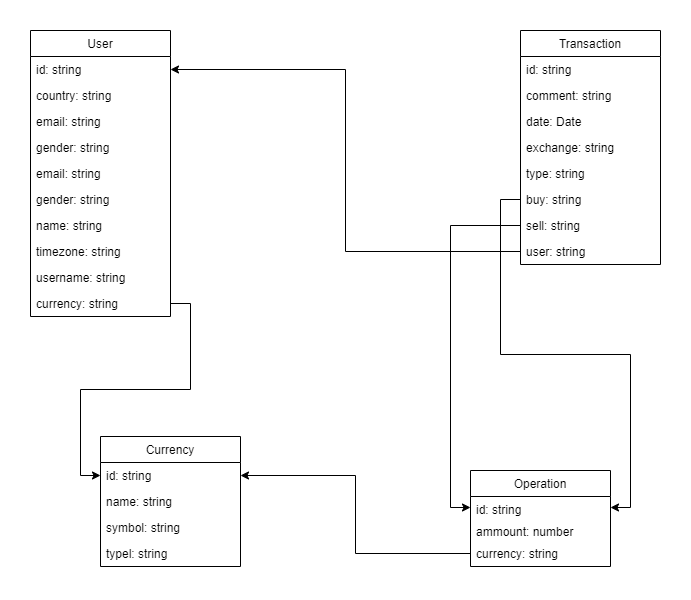The main goal of the project is to create a system that allows to track fiat and currency transactions. This system will allow users to easily and conveniently collect data about their portfolio in one place. The collected data can be used for analysis and, as a result, for making better financial decisions by the users of the application.
- support for the most popular fiduciary and crypto currencies,
- to enable the storage of transaction data,
- possibility of displaying historical data,
- presentation of portfolio data in a way that facilitates analysis
- application in client-server architecture,
- client module available through a web browser in the SPA station,
- communication between the server and the customer using REST,
- scalable and easy-to-maintain database with authentication
- possibility to create an individual account,
- manually add, delete and modify transactions,
- displaying transaction history,
- presentation of general portfolio data on the home page (value of the portfolio, ratio of individual currencies, etc.),
- presentation of statistical data of transactions by means of charts (time line transactions, etc.),
- synchronization with services providing information on current currency rates,
- possibility of downloading charts in the form of images / PDFs
- creating a database - 1h,
- creating repositories and basic projects - 1h,
- adding the frontend authentication - 3h,
- adding a backend authentication - 3h,
- implementation of database connection - 1h,
- creating a REST API with CRUD for models - 6h,
- finding and configuring services providing data on currency rates - 3h,
- implementation of logic for analytical data - 8h,
- frontend transactions form - 4h
- displaying the transaction - 4h,
- presentation of analytical data frontend - 6h,
- PDF generation - 3h
User authentication was solved using Firebase Auth and the library firebase/auth.
Registration consists of filling in the appropriate form (email and password). When the user enters the correct data, a profile is first created in the auth database, and then in Firebase. This order of operations is required because without the created auth profile we will not get the token required to verify the request to stat-profile-api.
// RegisterContainer.tsx
const submitHandler = handleSubmit(async ({ email, password }) => {
try {
await app.auth().createUserWithEmailAndPassword(email, password);
await createUser({
email,
country: '',
gender: '',
name: '',
timezone: Intl.DateTimeFormat().resolvedOptions().timeZone,
username: ''
});
push('/');
} catch (error) {
setError(error.message);
}
});
The request verification on the backend side has been resolved using firebase/admin. The user verification mechanism was placed in the Express middleware and consists of checking the token from the header of each request.
// Auth.ts
const auth = (req: Request, res: Response, next: NextFunction) => {
if (req.headers.authtoken) {
admin
.auth()
.verifyIdToken(req.headers.authtoken as string)
.then(() => {
next();
})
.catch(() => {
res.status(403).send('Unauthorized');
});
} else {
res.status(403).send('Unauthorized');
}
};
Firebase/admin also allows you to get the email of the user sending the query. This feature is used in controllers whose path contains /me.
// auth.ts
export const getUserEmail = async (req: Request) =>
admin
.auth()
.verifyIdToken(req.headers.authtoken as string)
.then(user => user.email);
Frontend automation is about listening to user status changes using the onAuthStateChanged method from the firebase library.
// AuthContext.tsx
...
useEffect(() => {
app.auth().onAuthStateChanged(user => {
if (authFlag) {
setAuthFalg(false);
setUser(user);
}
});
}, [authFlag]);
...
This change is then saved in a context state that can be used in other components.
Private routes- these are sub-pages that only the logged-in user has access to. They use AuthContextu. If an attempt is made to access a non-authenticated user, a redirection to the login page will be made.
// PrivateRoute.tsx
...
useEffect(() => {
if (!!user && isUnAuthRoute) {
push('/');
}
if (!user) {
push('/login');
}
}, []);
...
The portfolio-stat-web uses the library MobX and React Context to manage the global state. In addition to storing data, the store also has functions - actions. Sore is divided according to the types of stored data: analitic, currenncym opertion, transation and user.
// StoreContext.tsx
import store, { TStore } from '../Mobx';
export const StoreContext = createContext<TStore>({} as TStore);
const StoreProvider: FC = ({ children }) => (
<StoreContext.Provider value={store}>{children}</StoreContext.Provider>
);
// useStore.tsx
const useStore = () => useContext(StoreContext);
Analytical data presented in the application are calculated using current exchange rates. These data are fetch from the cryptocompare API using the library of the same name. This library provides both current and historical data (in a limited form).
The user can download data on the current status of the portfolio in any currency: /analitic/me/currencies/:currency. Example answer for USD:
{
ADA: {
raw: 200, // amount of currency
byCurr: 14.113999999999999, // value in USD
change: 8.802426214956723 // percentage change in price - 24 hours
},
BTC: {
raw: 1,
byCurr: 9539.16,
change: 1.2079870152469503
}
}
These data are calculated as follows:
app.get(`${basePath}/me/currencies/:currency`, async (req, res) => {
...
// Downloading all user transactions
const transactions = await getTransactions(req);
...
// Downloading current rates
const pricesList = await Promise.all(
currenciesHelper.map(
async symbol =>
(await cryptocompare.price(symbol, [currency]))[currency]
)
);
...
// Getting rates from before 24 hours
const histPricesList = await Promise.all(
currenciesHelper.map(
async symbol =>
(
await cryptocompare.priceHistorical(
symbol,
[currency],
yesterday
)
)[currency]
)
);
...
// Calculation of present value and percentage change
for (let symbol in currencies) {
currencies[symbol].byCurr = currencies[symbol].raw * prices[symbol];
currencies[symbol].change =
100 *
((prices[symbol] - histPrices[symbol]) /
((prices[symbol] + histPrices[symbol]) / 2));
}
res.json(currencies);
});
The project objective has been achieved. An application has been created that allows for saving, tracking and analyzing portfolio data. No difficulties were encountered during implementation.
In the future, the stat portfolio may be enriched with a larger amount of presented analytical data focusing e.g. on particular currencies, etc. Automation consisting in importing transactions from particular stock exchanges providing access to appropriate APIs would also bring great value. It is also possible to change the data flow from HTTP to WebSocket, which would allow to update the data in real time without having to refresh the whole page.




